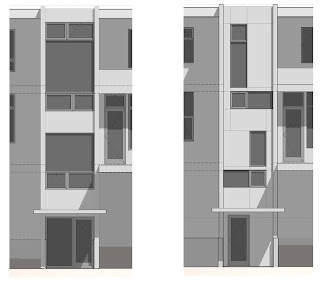The kitchen takes more design than most rooms, and you can't finalize a kitchen design without choosing the appliances. Accordingly, we recently spent a weekend (and then some) choosing appliances.
The easy choices
Our builder recommended Bosch where applicable. We did not have strong preferences on the
dishwasher,
refrigerator,
washer, and
dryer, so we chose low- to mid-range Bosch items. Yuval recommended Waste King garbage disposals, and so we chose a
reasonable unit
from their selection.
This brings us to the oven and cooktop. We spend more time interacting with these appliances, and that leads to more detailed requirements.
Ovens
We wanted double wall-mount ovens. A speed oven seemed like a perfect fit for the second oven. It would eliminate the need for a separate microwave and be smaller, faster, and more efficient. There was just one problem: Bosch does not sell a speed oven in the US.
Miele makes a popular, high quality speed oven. However, a
speed oven and
matching full-size oven from Miele is about $2000 more than a Bosch
double wall oven plus separate
microwave. With a $10,000 appliance budget, this is a big deal.
Fortunately, Yuval pointed out that the
high-end Bosch microwave is actually a combination oven. The difference is that the Miele speed oven is an oven first, microwave second, and can use both kinds of cooking methods together. The Bosch combination microwave is a microwave first, oven second, and can only use the cooking methods individually. We combined this with a
full-size oven to accomplish our main goals: no separate microwave and a smaller secondary oven. This came in about $2400 cheaper than the Miele combination.
Cooktop
We chose a 36" gas cooktop. We considered induction, but it is more expensive and the unit we saw had confusing controls. Gas is also what we are used to. A 36" cooktop will give us five or six burners, one or two more than the standard four.
We considered three different cooktops:
- The Bertazzoni Professional cooktop looks the nicest, but we were less fond of the mechanism for lighting the burner, and the simmer does not seem as good.
- The DCS cooktop has a nice simmer using a separate ring on all burners and a wonderful lighting mechanism. It costs slightly less than the Bertazzoni.
- The BlueStar drop-in cooktop costs the most and has an industrial look some may dislike. It has a nice lighting mechanism, good simmer on all burners (and one simmer-specific burner), more powerful burners (two at 22,000 BTU), and a knob layout arranged to match the burner layout. The burners use an open burner design which should provide more even heating.
Given its advantages, we decided to spend the extra for the BlueStar cooktop. The stove is our most used piece of equipment, so the splurge is worth the cost.
Because our stove is going on the island, we needed an island mount hood. It needed to be at least 42" (6" wider than the cooktop) and be powerful enough to match the stove. We chose a 48"
Kuppersbusch hood with 725 CFM of air exchange. That is more power than we need, but it is a good price and fits our needs. If it is more powerful than needed, we can use it on the lower (and quieter) fan speeds.
Totaling it up
The total cost for all of the appliances came out to about $10,000. It's only a bit over the initial budget we had set. With those settled on, we can freeze one part of the budget and finalize the kitchen design.
 Lit at night, water takes on the color of its container and the light. It distributes the light and color, creating a plane of light in the dark. The difference between day and night can be dramatic.
Lit at night, water takes on the color of its container and the light. It distributes the light and color, creating a plane of light in the dark. The difference between day and night can be dramatic. Still water reflects the surroundings like an imperfect mirror. In the dim evening light, it may be difficult to tell which image is reflection and which is reality.
Still water reflects the surroundings like an imperfect mirror. In the dim evening light, it may be difficult to tell which image is reflection and which is reality. Flowing water provides an ever-changing appearance. It is a natural, shifting piece that catches the eye and ear with pleasant noise.
Flowing water provides an ever-changing appearance. It is a natural, shifting piece that catches the eye and ear with pleasant noise.
















